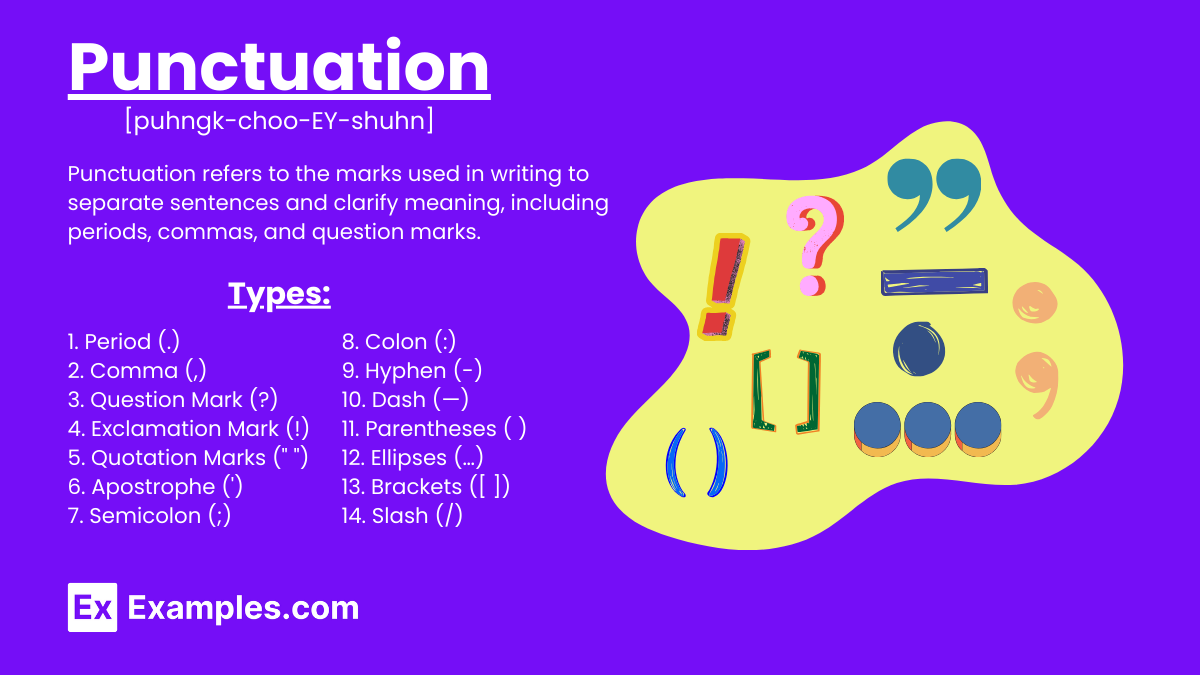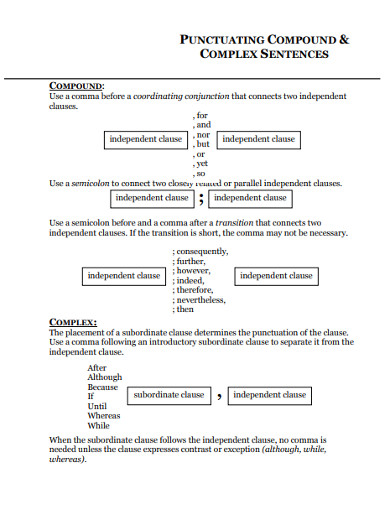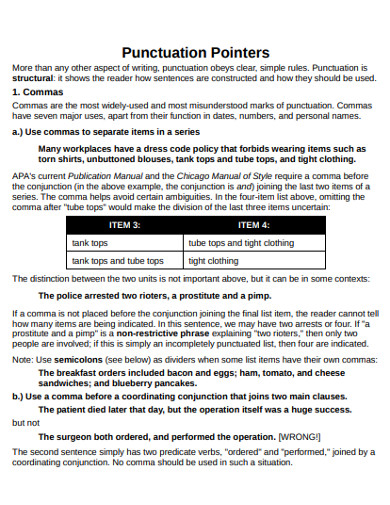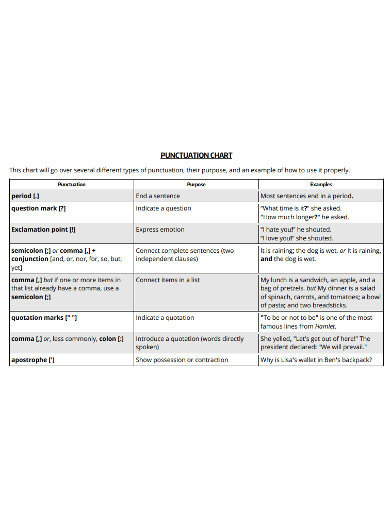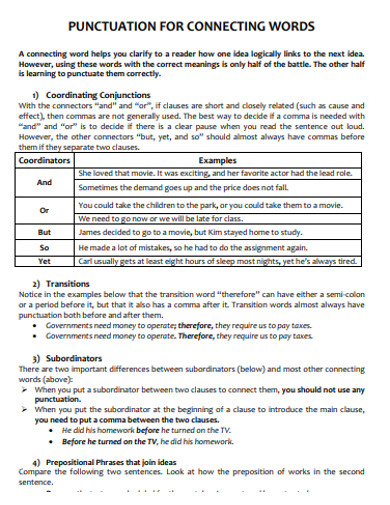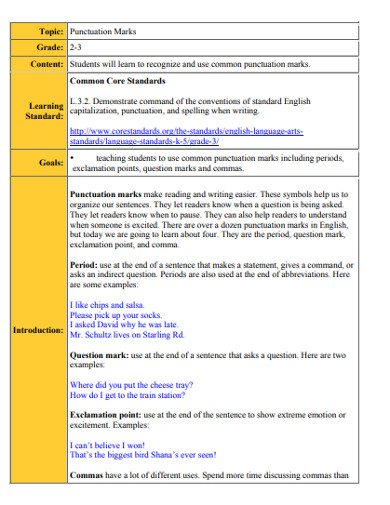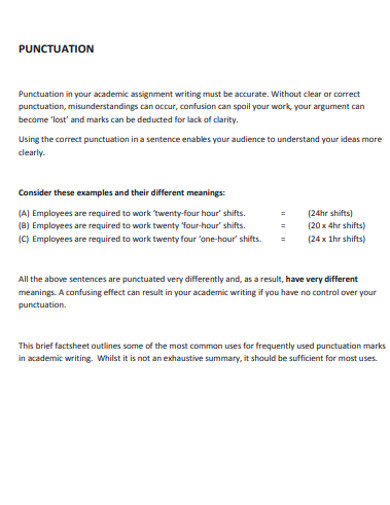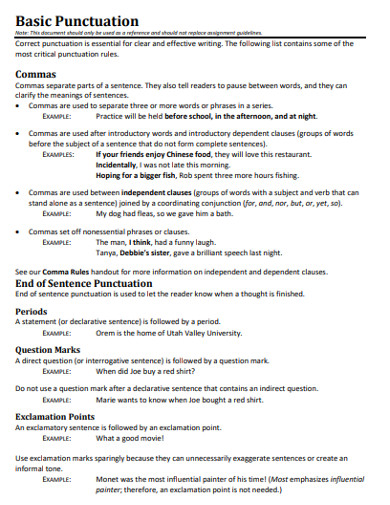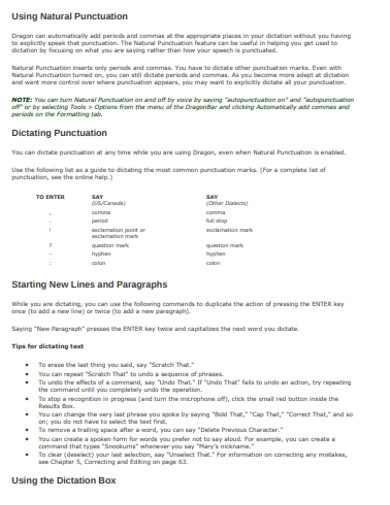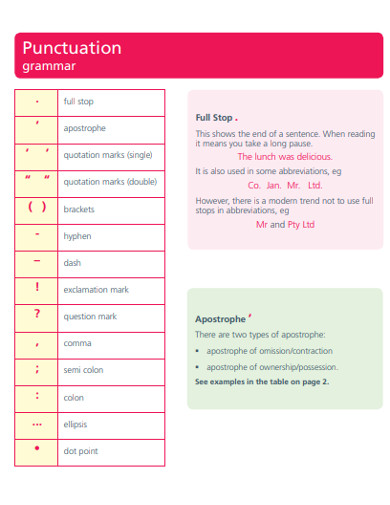50+ Punctuation Examples
Small things can make a big difference. This is especially true for the pivotal role of punctuation marks in language and communication. In the past, reading written texts wasn’t as easy as it is today. Aside from the absence of lowercase letters, there was no punctuation mark nor space in between words. You just had to figure your way into and out such a long thread of capital letters. ILOVECOOKINGPASTAANDYOU; how did we arrive at a point when a small comma could change that statement from cannibalism to an amorous confession?
There are over a million words in the English language. We only need to know about less than 2 percent of the English dictionary for us to be proficient in reading and writing. As words can be multi-faceted in definitions and usage, little grammatical symbols strategically placed along sentences help give meaning to what we say. But the story wasn’t always this way.
What is Punctuation?
Punctuation refers to the symbols and marks used in writing to separate sentences and clarify their meanings, making the text easier to read and understand. These marks help convey pace, tone, and structure, and indicate pauses and emphasis.
The Punctuation Marks in English Grammar
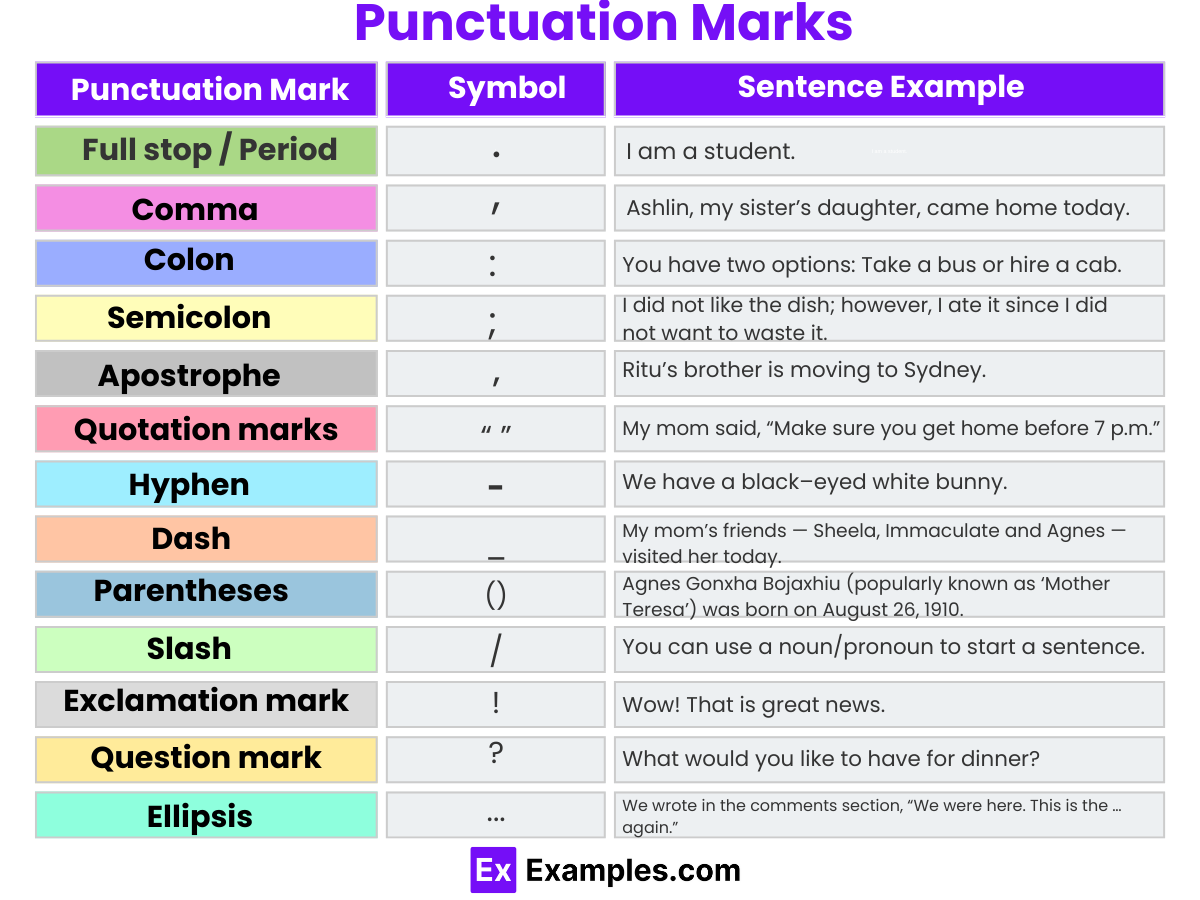
- Period (.) – Marks the end of a declarative sentence or statement.
- Comma (,) – Used to indicate a pause between parts of a sentence, list items, or to separate clauses.
- Question Mark (?) – Used at the end of a sentence to indicate a direct question.
- Exclamation Point (!) – Used to express strong feelings or a high degree of emphasis.
- Colon (:) – Introduces a list, a quotation, or a further explanation. It can also separate two independent clauses when the second explains or summarizes the first.
- Semicolon (;) – Links independent clauses that are closely related but could stand as sentences on their own. It’s also used to separate items in a list when those items contain commas.
- Quotation Marks (” ” or ‘ ‘) – Used to denote direct speech, quotations, or titles of short works like articles or poems.
- Apostrophe (‘) – Indicates possession (e.g., Mary’s book) or the omission of letters in contractions (e.g., don’t for do not).
- Dash (—) – Used to create a strong break in the structure of a sentence or to add emphasis to the enclosed text.
- Hyphen (-) – Used to join words or parts of words together, such as in compound terms (e.g., well-being).
- Parentheses (()) – Enclose information that clarifies or is used as an aside.
- Ellipsis (…) – Indicates an omission of words or a trailing off of thought.
Importance of Punctuation
- Clarity and Understanding: Proper punctuation ensures that the meaning of sentences is clear and unambiguous. For example, the placement of commas can drastically change the meaning of a sentence. Without correct punctuation, readers might misinterpret the intended message.
- Structural Flow: Punctuation marks like periods, commas, and semicolons help structure sentences and organize the flow of ideas within a paragraph. This structural guidance helps readers understand the relationships between various parts of the text.
- Tone and Emphasis: Punctuation can influence the tone of a text, such as creating emphasis or indicating a pause. For instance, exclamation marks can convey excitement or urgency, while ellipses can suggest a trailing off of thought or a suspenseful pause.
- Voice and Style: Writers use punctuation creatively to express their unique voice and style. The use (or deliberate omission) of certain punctuation marks can give writing a distinctive character or rhythm, much like a personal signature.
- Professionalism and Credibility: Correct use of punctuation reflects professionalism and attention to detail. In formal writing, such as academic papers, business correspondence, or published works, proper punctuation is critical for maintaining credibility and authority.
- Legal and Technical Precision: In legal and technical documents, precision is paramount. A misplaced comma or period can alter the interpretation of contractual obligations or technical specifications, potentially leading to misunderstandings or legal disputes.
Punctuation Rules
Here are some essential punctuation rules with explanations and examples:
1. Periods (.)
- Use: To end a declarative sentence, a statement, or a command.
- Example: She went to the market.
2. Commas (,)
- Use: To separate items in a list, after introductory words or phrases, before conjunctions in compound sentences, and to set off nonessential information.
- Examples:
- List: I bought apples, oranges, and bananas.
- Introductory phrase: After dinner, we went for a walk.
- Compound sentence: I wanted to go, but it was too late.
- Nonessential information: My brother, who lives in New York, is visiting.
3. Semicolons (;)
- Use: To link closely related independent clauses and to separate items in a list when the items contain commas.
- Examples:
- Independent clauses: She loves reading; he enjoys writing.
- Complex list: We visited Paris, France; Rome, Italy; and Berlin, Germany.
4. Colons (:)
- Use: To introduce a list, a quote, an explanation, or to separate two independent clauses when the second clause explains or illustrates the first.
- Examples:
- List: You need to buy the following items: bread, milk, and eggs.
- Quote: She said: “I’ll be there soon.”
- Explanation: He had one goal: to win the race.
5. Question Marks (?)
- Use: At the end of a direct question.
- Examples:
- Where are you going?
- Did you finish your homework?
6. Exclamation Marks (!)
- Use: To show strong emotion or emphasis.
- Examples:
- Watch out!
- That was amazing!
7. Quotation Marks (” “)
- Use: To enclose direct quotes, titles of short works, and to indicate dialogue.
- Examples:
- Direct quote: “She said, ‘Hello.'”
- Titles: “The Tell-Tale Heart” by Edgar Allan Poe.
- Dialogue: “I’ll meet you there,” he said.
8. Apostrophes (‘)
- Use: To show possession and to form contractions.
- Examples:
- Possession: Sarah’s book, the dog’s leash.
- Contractions: Don’t (do not), it’s (it is).
9. Hyphens (-)
- Use: To join words in compound terms and to split words at the end of a line.
- Examples:
- Compound terms: Mother-in-law, well-known.
- Word split: The editor-in-chief decided to re-examine the manu- script carefully.
10. Dashes (–, —)
- Use: To create emphasis, to indicate a range, or to set off parenthetical information.
- Examples:
- Emphasis: She gave him her answer—a resounding no.
- Range: The event runs from June 1–5.
- Parenthetical information: My friend—a talented artist—won the competition.
11. Parentheses ( )
- Use: To enclose additional information or asides.
- Examples:
- Extra information: He finally answered (after five minutes of thinking) that he did not understand the question.
12. Ellipses (…)
- Use: To indicate the omission of words or a trailing off in thought.
- Examples:
- Omission: “To be continued…”
- Trailing off: “I’m not sure what to say…”
13. Brackets ([ ])
- Use: To add information or clarification within quoted text.
- Examples:
- Clarification: “He [the president] will be attending the meeting.”
14. Slash (/)
- Use: To indicate alternatives or fractions.
- Examples:
- Alternatives: Please bring your parent/guardian.
- Fractions: 1/2, 3/4
Punctuation Examples in Sentences
1. Period (.)
- She went to the store.
- The sun sets in the west.
- He enjoys playing soccer.
- We visited the museum yesterday.
- The cake is in the oven.
2. Comma (,)
- I bought apples, oranges, and bananas.
- After dinner, we watched a movie.
- She likes coffee, but he prefers tea.
- My brother, who lives in New York, is visiting.
- To be honest, I don’t know the answer.
3. Question Mark (?)
- Are you coming to the party?
- What time does the meeting start?
- Do you know how to solve this problem?
- Where did you put the keys?
- Can you help me with this project?
4. Exclamation Point (!)
- Watch out!
- That’s amazing!
- I can’t believe we won!
- Happy birthday!
- Stop right there!
5. Colon (:)
- She brought three things: a book, a pen, and a notebook.
- He said it best: “Practice makes perfect.”
- The recipe calls for three ingredients: flour, sugar, and eggs.
- There are two choices: stay or leave.
- Here’s the plan: finish the project by Friday.
6. Semicolon (;)
- She loves reading; he prefers writing.
- The meeting included representatives from Paris, France; Berlin, Germany; and Rome, Italy.
- We can go to the park; it’s a beautiful day.
- I wanted to join the team; however, I was too late.
- She is my best friend; we’ve known each other for years.
7. Apostrophe (’)
- John’s car is new.
- It’s raining outside.
- The cat’s toy is under the table.
- She can’t find her keys.
- The children’s playground is closed.
8. Quotation Marks (” “)
- She said, “Hello.”
- I love the poem “The Road Not Taken.”
- “Can you help me?” he asked.
- “It’s a beautiful day,” she remarked.
- “Don’t forget to call me,” he reminded.
9. Parentheses ( ( ) )
- She finally answered (after taking five minutes to think) that she did not understand the question.
- The event (which was scheduled for Friday) was postponed.
- I bought a new phone (it was on sale).
- He is a great player (when he wants to be).
- The book (which I haven’t finished yet) is on the table.
10. Dash (– or —)
- He was going to propose — but he changed his mind.
- The event is scheduled for June 5–7.
- She won the race — a surprising victory.
- The decision — though controversial — was final.
- There’s something I need to tell you — something important.
11. Hyphen (-)
- My mother-in-law is visiting.
- He is a well-known author.
- The state-of-the-art facility is impressive.
- They live in a three-story house.
- The decision was a last-minute one.
12. Ellipsis (…)
- She started to speak, but then… she stopped.
- To be continued…
- I was thinking about what you said… and I agree.
- He hesitated… then replied.
- The story goes on and on…
More Punctuation Examples
Learn more about punctuation marks and their uses from the following sample guides and charts.
1. Punctuation Compound and Complex Sentence
2. Punctuation Pointers Example
3. Punctuation Chart Example
4. Punctuation for Connecting Words Example
5. Punctuation Marks Example
6. Sample Punctuation Example
7. Notes on Punctuation Example
8. Basic Punctuation Example
9. Natural Punctuation Example
10. Punctuation Grammar Example
11. Punctuation Exercise Example
Improving Punctuation Symbols
Avoid some of the common punctuation errors with the following tips.
1. Commas and Subordinates
Subordinates are phrases although, because, before, unless, however, even though. When they are placed in the middle of sentences, they usually do not need a comma. However, when placed at the start of the sentence, subordinates need a comma to support the other clause.
2. Commas and Conjunctions
These are the phrases for, and, nor, but, or, yet, and so. Conjunctions usually need commas to help them carry a complete sentence. That is when they are in between independent and dependent clauses. Yet, there are times when commas aren’t necessary. These are when the conjunction is adjoining a word or phrase that isn’t a clause.
3. Apostrophe Usage
Apostrophes are like superscript commas. They are used to denote ownership or possession and are typically followed by the lower case s. Don’t use apostrophes when you mean the plurality of most things, except when you mean the plural of lowercase letters such as a’s and b’s, and of abbreviations.
4. Parenthetical Confusion
When you need to add extra information to the text, you can rely on a pair of parentheses. It can enclose word, phrases, or sentences. But where do we place the period mark? When you use the enclosed text to enhance the meaning of the sentence, and the text doesn’t exist on its own, place the period outside the closing parenthetical symbol. However, when the closed text can stand as a sentence on its own, dot the sentence outside the inside parenthetical mark.
The Pre-punctuation Period
In the early days of written language, symbols denoted words. Since the words were contained and separated in individual imager vessels, there was no need to place spaces and marks between them.
The Ancient Greeks, however, did not follow this symbolic language. Their writing system was adapted from the Phoenicians who journeyed from Lebanon. These maritime traders and merchants had a phonetic writing system instead. They use letters instead of symbols. The Greek writing system wasn’t ambiguous, unlike the syllabic and logographic language of that of the Mayan and Chinese.
As useful as their written language is in conveying speech, it lacked spaces and symbols that distinguished words from other words and sentences from another sentence. Readers wouldn’t understand the written text on the first read, much more articulate it eloquently.
At the end of the 3rd century BC, symbols, the precedents of modern punctuation marks, were first used in texts to separate the words and add necessary pauses in between. This became popularized as mainly for the purpose of speaking. The Greek ancestors of the modern punctuation marks were made to indicate how much text each mark separated. For example, comma divided words and phrases, colon separated clauses, while period meant the end of a sentence. The spaces between words weren’t a convention until around the 7th and 8th centuries when Irish and Scottish monks used them in passages. It was also during the latter century when the lower case letters became part of the written alphabet.
Punctuation In Printing
Things were simpler when you wrote by hand. It took a while before punctuation marks became a convention for printing press. And it took an Italian typographer and his grandson to catalyze the standardization of punctuation symbols into print. During the 15th century, Aldus Pius Manutius was the first to use comma and semicolons in publishing. When his grandson, Aldo Manutius the Younger, became in-charge of the family business, he took a page from how the Ancient Greeks used symbols. He cataloged the use of commas, colons, and periods, with new members to the list: quotation marks, exclamation points, apostrophe, and question marks.
When punctuation marks became the standard, everybody started using them. So much so that they were needlessly overusing the symbols. Today, we have lexicographers in the names of Henry and Francis Fowler to thank for codifying the proper and correct use of punctuation symbols at the start of the 20th century.
Symbols and Lexicon
Punctuation marks, small as they may be, can change the entire meaning of a statement. When used incorrectly, the symbols can alter the intended meaning of the sentence and can lead to misunderstandings.
In the example “I love cooking pasta and you,” different comma placements will change the meaning of the sentence. For example, “I love cooking, pasta, and you” means the speaker is fond of the activity cooking, of the food pasta, and the receiver of the statement. When we place the comma in between pasta and and only, we have “I love cooking pasta, and you.” The speaker is enamored with preparing pasta as he or she is with the receiver. When we omit the comma altogether, we have a rather cannibalistic statement that is a far cry from love for the other person.
In a similar manner, “You’re leaving me” is an imperative statement. The speaker declares that the other person is moving away from him or her. Meanwhile, “You’re leaving me?” means that the speaker is asking if the other person is deserting him or her. The small difference seems negligible, but it can spark confusion and argument between people. Therefore, the correct use of punctuation marks is important for both syntactical and elocutionary purposes of language.
What is the purpose of punctuation?
Punctuation clarifies meaning, separates ideas, and indicates pauses or intonation in writing, enhancing readability and comprehension.
When should I use a period?
Use a period to end declarative sentences, statements, and indirect questions. Example: “She went to the store.”
How do commas work in lists?
Commas separate items in a list. Example: “I bought apples, oranges, and bananas.”
What is the difference between a semicolon and a colon?
A semicolon connects related independent clauses or separates complex list items. A colon introduces lists, quotes, or explanations.
When do I use an apostrophe?
Use an apostrophe for possession (John’s book) or contractions (it’s raining).
What are quotation marks used for?
Quotation marks enclose direct speech, quotes, and titles of short works. Example: “She said, ‘Hello.'”
How do I use parentheses?
Parentheses add extra information or clarification. Example: “He found a coin (it was shiny) on the ground.”
When should I use a dash?
Use a dash for emphasis, interruptions, or to indicate ranges. Example: “He was going to propose — but he changed his mind.”
How do I use a hyphen correctly?
Hyphens join words or parts of words. Example: “Mother-in-law” or “well-known author.”
What does an ellipsis indicate?
An ellipsis indicates omissions or pauses in thought. Example: “She started to speak, but then… she stopped.”



